FLOORING OPTIONS: A GO-TO GUIDE
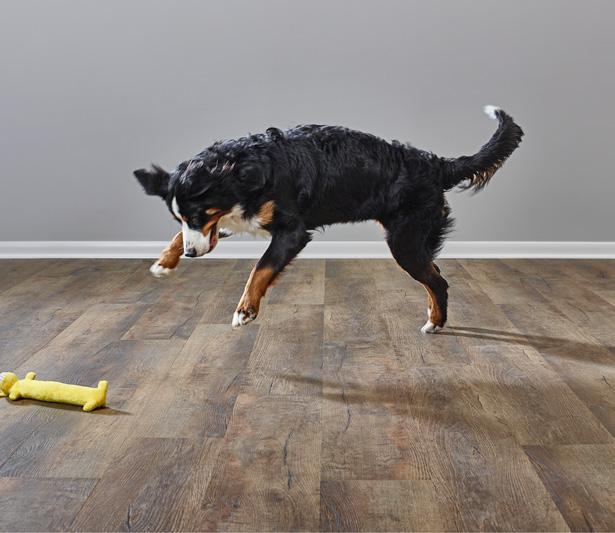
MENU
Flooring Options: A Go-To Guide Ditching Flooring Fads for Fab Results Speaking the Eloquent Language of Solid Hardwood Taking Another Look at Engineered Hardwood Talking About Tile for Busy, Beautiful Surfaces Learning the Secrets to Using Luxury Vinyl Tile and Planks Creating a Softly Stunning Room with Carpeting Considering Environmentally Safer Flooring Paying Attention to the Right Commercial Floors Bringing Your Flooring Decisions Together Residential Flooring Checklist Commercial Flooring Checklist FLOORING OPTIONS: A GO-TO GUIDE 3 4 6 8 9 11 13 15 16 18 19 20
TABLE OF CONTENTS
FLOORING OPTIONS: A GO-TO GUIDE
If Hollywood awarded a statue for hardest-working surface, flooring would probably snag the trophy every time. Really, it should. Flooring doesn’t just have to cushion bare soles, endure the unrelenting tip-tap of footwear, and support heavy furnishings. It also has to enhance a room’s design elements.
In other words, floors are the unsung heroes of any renovation project.
Whether you’re a builder, contractor, designer, installer, or remodeler diving into flooring, your task is to pick a material that’s stylish, perfect for the space, and affordable. Fortunately, you have thousands upon thousands of flooring material choices. But sometimes, all those choices can muddy the waters, making it tough to decide, even if you’ve worked as a contractor, renovator, or interior designer for years.
Rest assured that making a perfect choice isn’t as tough as it initially seems. All you need is some guidance from your friends at ProSource Wholesale®.
Coupling our expertise and industry leadership, we’ve researched flooring trends and options to make your process simpler by focusing on different types of surfaces, their inherent advantages, and general recommendations. Just kick back and read on to nail down (or glue, if you’re talking about certain laminates) the ideal floor for any space.
FLOORING OPTIONS: A GO-TO GUIDE 3
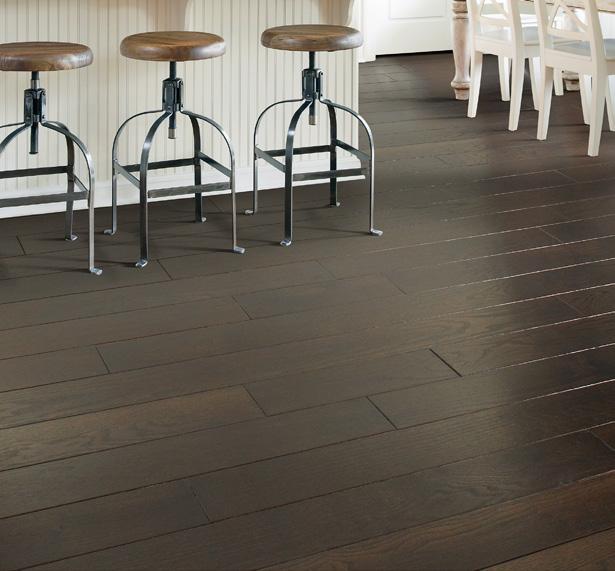
DITCHING FLOORING FADS FOR FAB RESULTS
Ready to debate the virtues of carpet pile or rave about the eye-catching appeal of textured hardwood? Before diving too deep, let’s talk about the elephant in the room: flooring fads. After all, they’re out there, and they can sideline your flooring game fast.
What’s the risk of jumping into a flooring fad instead of embracing a more enduring trend? Essentially, you’ll never be able to keep up. Sure, fads can sound fun, but they’re a huge trap. Within a year or two, the fad will change — and the flooring will need to be updated. Unless your client has given an unlimited budget to work with and knows the risk, she won’t appreciate discovering that her living room, bedroom, kitchen, or bathroom floor will be in style for just two years.
Consequently, you’ll want to suggest and adopt flooring trends that have stability. For instance, remodelers, builders, and interior design pros are leaning toward
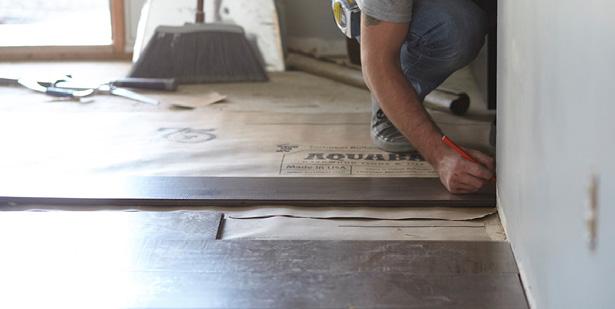
FLOORING
4
OPTIONS: A GO-TO GUIDE
timeless flooring options. Homebuyers seem to prefer lighter-colored hardwood floors as opposed to darker hardwoods in most of their rooms. Accordingly, all tones of light finished oak flooring planks have become enormously popular products. And they’re likely to stick around for at least a decade, giving them tremendous staying power.
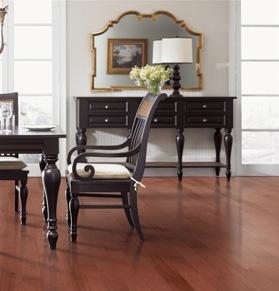
Worried your flooring muse will feel stilted if you stick to the mainstream? Love the idea of being on the leading edge of home decor? You don’t have to ditch your desires for innovation. Simply decorate and punctuate areas with colors, patterns, textures, and styles that might not be in vogue next year but are convenient (and not expensive) to replace. Throw pillows, wall hangings, and paint require less investment than ripping up floors and laying down a completely new surface.
Transforming a home or commercial space into a contemporary showpiece with maximum flair can be done by leveraging floor trends destined to have a longer life span than a smartphone.
 FLOORING OPTIONS: A GO-TO GUIDE 5
FLOORING OPTIONS: A GO-TO GUIDE 5
SPEAKING THE ELOQUENT LANGUAGE OF SOLID HARDWOOD
Solid hardwood floors consistently rank high as attractive assets. Check any website that lists homes for sale: You’ll notice right away that hardwood floors are regularly highlighted to entice buyers. In fact, information from FloorDaily.net insists that homes featuring hardwood floors spend less time on the market and receive more and/or higher bids than counterparts. That’s something your renovation clients will love to hear, and it’ll help them understand the intrinsic value of paying for a hardwood install.
Want another reason to recommend solid hardwood to your customer base? How about its enduring properties? Real hardwood ages gracefully. It doesn’t evoke a stuffy or dated look; somehow, it’s always fresh and modern, even if it’s made from reclaimed wood that came from an 1850s barn. Plus, plenty of hardwood options exist on the market, making it simple to find the right fit for even picky buyers.
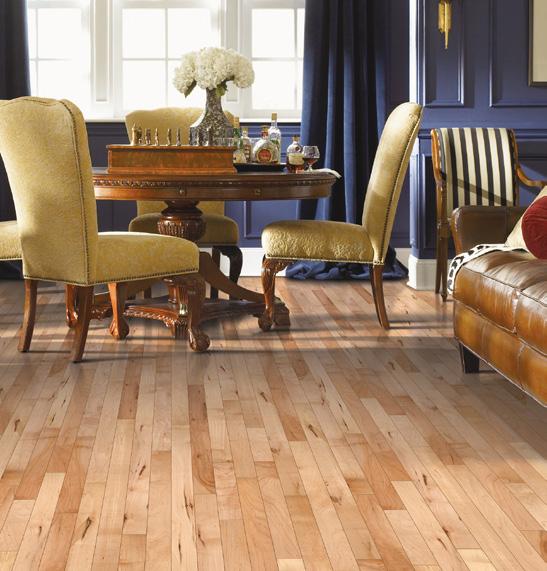
FLOORING
6
OPTIONS: A GO-TO GUIDE
Let’s talk tone, too. The color choices for hardwood vary tremendously. As a contractor or interior decorator, you can choose between light, medium, and dark finishes — regardless of the base wood (although some woods are naturally darker than others, like cherry and mahogany).
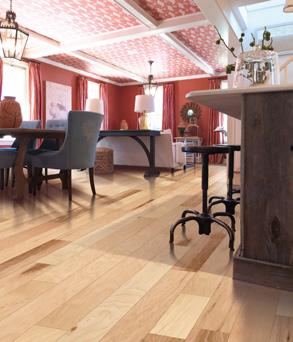
Although light finishes are common in hardwood floors constructed of white oak, maple, and pine, a completely light floor isn’t a requirement. Instead, floors finishes can alternate between light and dark or light and medium to give a room more character and depth. You may even consider using a variety of available plank sizes to jazz up an indoor area and give it a colorful “pop.” You can thank Mother Nature for her variety when your clients write stellar online reviews raving about your work!
Addressing a smaller room, like a hallway or galley kitchen? Not sure how to maximize real estate in tight quarters? Light hardwood floors, especially when installed on the diagonal or in a chevron pattern, add the perception of increased square footage. Add some other light colors on the walls — as well as a few bright spots of furnishings and fixtures — and suddenly a room can turn from cramped to breathtaking. Best of all, it happens in a way that doesn’t require any wall widening or removal.
Is a dark finish the desired look for your clients? Are you committed to bucking the light hardwood trends in favor of making your customers’ dreams come true? Just be cautious and upfront when advising clientele: Dark hardwood flooring is more likely to show scratches, pet hair, and other marks easier than light hardwood flooring will. With that awareness — and a satin finish to hide future imperfections from boots, heels, pet claws, toys, and dropped objects — you’ll be good to go.
FLOORING
7
OPTIONS: A GO-TO GUIDE
TAKING ANOTHER LOOK AT ENGINEERED HARDWOOD
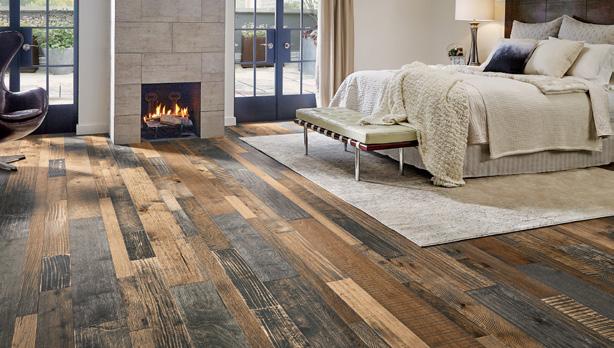
You’ve been tasked with the impossible: Your customer loves real hardwood but is uncertain about going completely into the solid plank market. What’s a contractor, renovation professional, or interior designer to do?
No need to fret, because you’re in luck. Engineered hardwood flooring is real wood with a twist. Instead of being one long plank of wood, the wood is layered thinly over plywood. Not only does this give the plank added performance, but it also allows one piece of wood to “stretch” into several planks.
Like what you hear? You’ll be especially pleased to learn about engineered hardwood installation if you haven’t had the opportunity. Engineered wood floors install like a dream: Just nail, glue, or staple them in place, following their recommended guidelines. Then, sit back and let your clients enjoy the engineered hardwood’s durability, stunning looks, and earthy tones.
Having trouble deciding between solid or engineered hardwood flooring? Ask yourself or your customer if there’s a need for a moisture-resistant floor, one that’s able to hold up under lots of wear and use. If the answer is “yes,” engineered hardwood floors might be a better fit. They won’t be as likely to warp in high humidity, yet they’ll retain the lushness and polish of solid hardwood planks. Additionally, engineered floors have the advantage of being better suited for below-grade (like basements) and bathroom installs — both spaces moisture likes to live.
FLOORING OPTIONS: A GO-TO GUIDE 8
TALKING ABOUT TILE FOR BUSY, BEAUTIFUL SURFACES
Ah, tile. It’s back again and ready to excite your imagination and fulfill your clients’ desires.
Once relegated to the bathrooms and kitchens of the world, tile is enjoying a renaissance of massive proportions. Today, you’re just as apt to find porcelain and ceramic tile in dens, man caves, hallways, dining rooms, and outdoor spaces as you are in kitchens and baths. Yet you might not realize at first glance that the floor beneath your feet is tile. After all, tile has grown up in the past few decades.
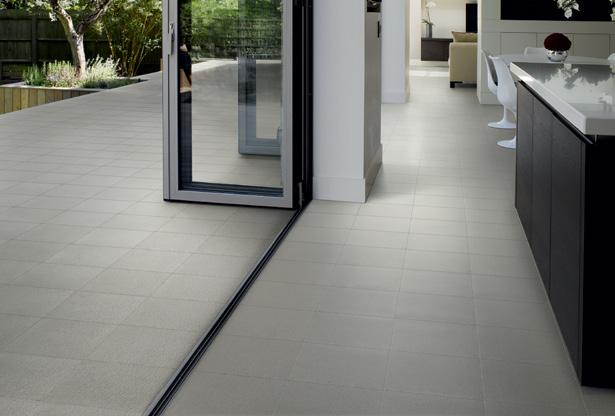
What’s the backstory on tile’s evolution from its teen years to adulthood? At one time, tile was, well, tile. It was white or black, typically, and came in squares. Hence, many mid-century modern bathrooms were tiled in precise checkerboard patterns (although they did play around with light pink and light green tiles for a little fun).
Fortunately, you’re designing in the 21st century, which means you have tons of exceptional tile flooring to tempt your interior design tastes and desires. And it doesn’t have to look like the tile in your great-grandmother’s house — unless you want it to.
FLOORING OPTIONS: A GO-TO GUIDE 9
Just how different is tile today from the tile of yesteryear? It’s so dramatically updated, you’ll be amazed how much you can do to a home.
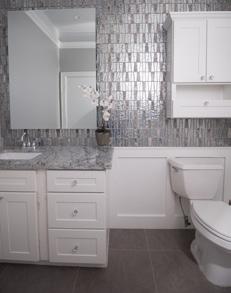
Truly, tile has come into its own. Thanks to clever engineering, tile can be made from tons of materials. Consider this: If you’re thinking of putting in a stone floor (but need to avoid the price tag associated with laying real stone floors), tile can provide a stone aesthetic without the high cost. The same is true for tile that mimics the look and even texture of wood. Without getting close to it, it’s unlikely anyone will know the difference.
Of course, you still have the classic tile looks to choose from, including black porcelain tile — always in vogue for snazzy bathroom and kitchen floors — as well as backsplashes. You don’t have to stick with glossy black tile if you want a black tile look. Black tile (and other varieties) embossed and embedded with a host of decorative elements is on the market, ready to spice up any flooring area.
Top off your toast to tile by getting a little clever visually: Consider mixing tile media. Designers and homeowners alike are merging decorative wood and stone tiles in intricate patterns on floors, countertops, and other surfaces. While you’ll want to map out a plan in full before attaching the tile permanently to any areas, plenty of ways exist to let your imagination run free with a little help from tile.
If you’re interested in learning more about the value and advantages of tile for all or part of a living space, visit your local ProSource showroom and explore our samples. Then, bring them to your clients to “live with” for a few days. By laying out the tile in intended spaces before install, a clearer indication will emerge of how well they’ll fit the intended ambiance, charm, and style.
FLOORING
10
OPTIONS: A GO-TO GUIDE
LEARNING THE SECRETS TO USING LUXURY VINYL TILE AND PLANKS
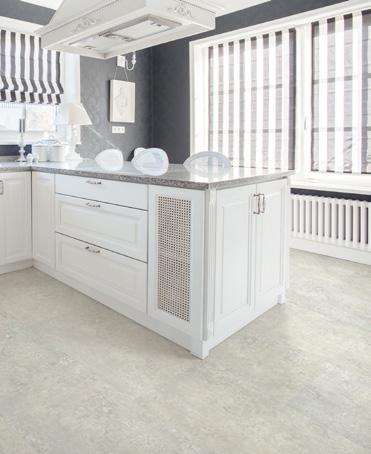
When you hear the words “vinyl tile,” you might immediately think of 1970s horror kitchen images. Perish the thought! Fortunately, luxury vinyl tile leaves its ancient cousins in the dust when it comes to decorating, putting it several steps up from the vinyl you remember as a kid.
Luxury vinyl tile isn’t just easy on the eye, though; it’s also easy to install. This allows you to get the look your clients want for less. Homeowners with tight budgets — and designers looking to keep those tight budgets in check — opt for luxury vinyl tile when they realize it costs less than traditional tile but can still echo the function and feel of tile floors.
Wishing for a hardwood ambiance at wholesale vinyl flooring prices? Try luxury vinyl planks, available in a wide range of hardwood aesthetics without any of the moisture concerns that come with hardwood. For example, if you’re planning to
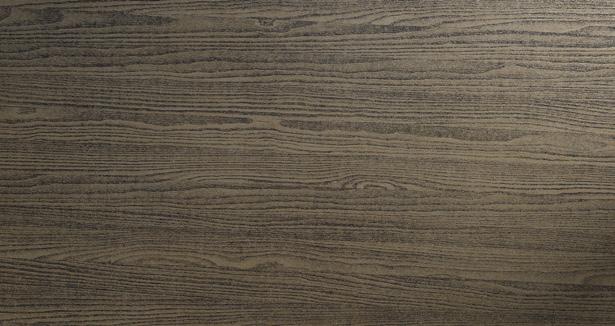
FLOORING OPTIONS: A GO-TO GUIDE 11
add hardwood to a kitchen in a historic home with high humidity and no central air, vinyl planks can do the trick. Your clients will appreciate how well it holds up to dings and scratches — just like vinyl tile — while loving the way it appears underfoot.
For those who don’t have time to regularly clean a hardwood floor (or even an engineered hardwood floor), luxury vinyl planks can be a lifesaver. A polyurethane finish promises simple maintenance. Just use a favorite environmentally friendly cleanser, your smart home vacuum, or an old-fashioned broom to wipe up. Pesky stains from grape juice or red wine? They’ll mop up in no time flat.
So which luxury vinyl tile or planks are best-suited for your next big client do-over? Look for products that are at least 20 millimeters on top; that way, they’ll hold up under normal wear and tear. Love a vinyl tile or plank that’s a bit thinner? As long as you install it in an area that isn’t heavily used, your clientele will rave about the results. Worried about the environment? Many luxury vinyl tile and plank products offer lower volatile organic chemical emissions (VOCs), helping ensure your indoor air quality is as particle-free as possible.
Of course, knowing the value of luxury vinyl is one thing; knowing how to make it dazzle any residential or commercial space is another. Once again, our experts can help!
How can you use vinyl tiles or planks to streamline the design you have in mind for one or more rooms? First, figure out the overall theme for each room, level, or entire residence or property. Then, check into a luxury vinyl that fits your goal. Ideally, you’ll want to choose one that achieves your vision, whether that’s having a floor that looks ceramic but is groutless or one that has the appearance of your favorite natural hardwood.
If you’re not completely sure luxury vinyl tile or planks are ideal for your upcoming project or bid, explore the luxury vinyl choices in ProSource Wholesale’s online catalog. You’ll be amazed how either can look almost identical to hardwood — without necessitating the care and upkeep hardwood flooring requires. In other words, don’t be afraid to explore luxury vinyl: It’s a secret product many interior designers, contractors, and builders swear by.
Express your individuality without weighing down your wallet with luxury vinyl tile or luxury vinyl planks. The money saved can go into other areas of your home makeover project, like furniture, wall paint, decor, and window treatments. And while you could still buy sheets of vinyl if you wanted, with luxury vinyl tile or planks, you have far greater control over the end result.
FLOORING OPTIONS: A GO-TO GUIDE 12
CREATING A SOFTLY STUNNING ROOM WITH CARPET
Carpet has never gone out of style, and it probably never will. What room doesn’t call for a soft surface now and again? Even homeowners with hardwood flooring, engineered hardwood flooring, or luxury vinyl planks often insist on purchasing throw rugs for some sole-cuddling plushness.
Like all flooring types, carpet has evolved greatly in the past few years, to the delight of contractors, interior designers, and homeowners. Haven’t been shopping for it recently because your customers have been all about hardwood or vinyl? Wait until you see all carpet varieties on the market, not to mention their assets.
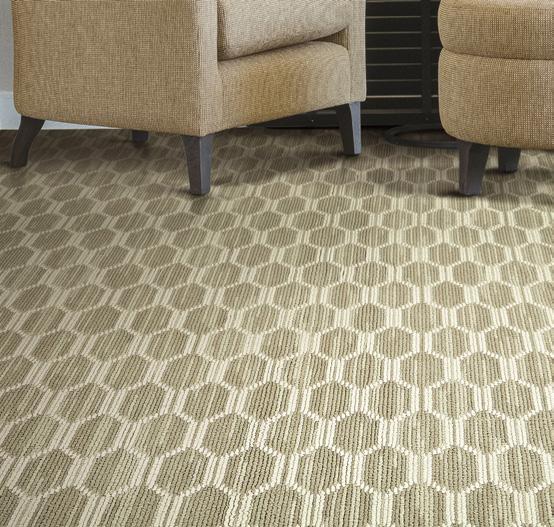
For instance, you may not realize carpet has joined the environmentally conscientious bandwagon and gone green (not necessarily in shade, of course).
How is eco-conscious carpeting created? It can be constructed from recycled materials or can be manufactured to be recycled. Don’t worry, though: It still works
FLOORING OPTIONS: A GO-TO GUIDE 13
as well as other types of carpet, and you’ll never know the difference. In addition, some eco-friendly carpets come waterproofed already, allowing homeowners to fret less about liquid spills seeping through to the floor beneath.
As if that weren’t enough reason to consider adding carpet to an upcoming client remodeling project, eco-conscious carpet offers incredibly low VOC emissions. At the same time, it traps dust almost like an air filter. One Carpet and Rug Institute research project found that people with allergies and asthma felt better when they were in carpeted areas. That’s a true bonus for anyone suffering from temporary or chronic respiratory illnesses or conditions.
From a practical standpoint, carpet can be a wonderful noise barrier, too. If a house tends to have “thin” walls, carpet can insulate the upstairs and downstairs. It can also be a safer surface for little children or babies just learning to walk.
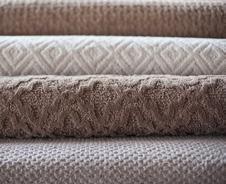
Clients worried about committing to wall-to-wall carpeting? Show them other options. Carpet tile comes in large sections, perfect for dens or family rooms where a section could be damaged by spills and thrills. Replacing a carpet tile piece is certainly less problematic than reinstalling an entire carpet, but it looks just as lovely.
In terms of trends, bold throw rugs and ombre carpets are highly encouraged for adding character to any room or hallway. If a unique carpet covering is sought, fear not: All carpet can be bound into a custom area rug of any size and used wherever desired. If you’re not certain how to use carpeting to change the way any area looks and feels, get expert insights from ProSource Wholesale on carpet flooring trends.
Which color should you pick for the carpet flooring in your project? Sherwin Williams hopes its 2019 color of the year, Cavern Clay, will catch your attention. It’s a dramatic hue that captures the cozy, cooler side of interior design.
Benjamin Moore’s color of the year, Metropolitan AF-690, is also in the gray hue family — it’s a neutral, soothing color the paint brand says is “not arresting nor aggressive.”
Whatever your clients’ goals, adding a cooler earth tone here and there promotes luxury and calm. Who wouldn’t want to feel like they’re donning their favorite sweater on a cool October evening by the fire, whether in the form of wall-to-wall carpeting or an innovatively designed area rug?
14
FLOORING OPTIONS: A GO-TO GUIDE
CONSIDERING ENVIRONMENTALLY SAFER FLOORING
Is being a smart steward of our natural resources important to you and your clients? Good news: No matter what type of flooring you lay in a home, you can always find a choice that can be both beautiful and sustainable.
For instance, many people who love the idea of hardwood floors are picking sustainably sourced bamboo flooring. Although its upfront wholesale flooring price might be a little higher than with other hardwood, bamboo flooring is becoming a highly sought-after floor type by homebuyers. In addition to being environmentally friendly, it resists staining, scuffing, and scraping.
Bamboo doesn’t grab your attention? Consider cork. Natural cork is waterproof and long-lasting; it also feels great underfoot. Why else would the New York City Public Library install cork floors 100 years ago if the institution didn’t expect it to survive year after year?
Still want hardwood but worried it’s not eco-friendly? You can get authentic wood that’s harvested in a way you’ll feel good about. It’s processed using natural oils to bring out its genuine good looks. Like most hardwood flooring, it can be relied on decade after decade.
Rounding out all the eco-friendly flooring options, remember that tile can be in that club, too. Just ask your ProSource team member about durable selections that exude personality (but not VOCs or anything else you don’t want in the house).
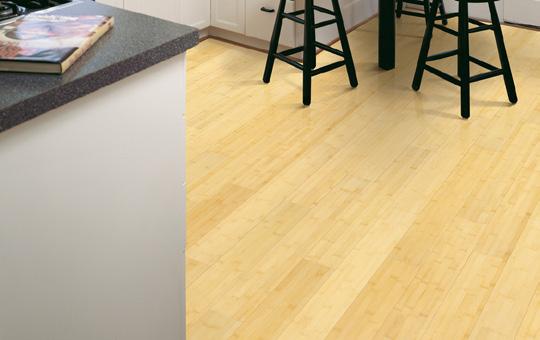
FLOORING OPTIONS: A GO-TO GUIDE 15
PAYING ATTENTION TO THE RIGHT COMMERCIAL FLOORS
Thus far, we’ve talked primarily about residential flooring, but you may also have a need for commercial flooring. For instance, if you’re renovating a home office, you may require something offering simple maintenance and low cost.
Although design trends are important when determining which commercial flooring will be a practical solution for a home business or headquarters, you’ll want to put other considerations first. After all, it’s usually more expensive — not to mention more time-consuming — to reinvent a commercial space every year or so.
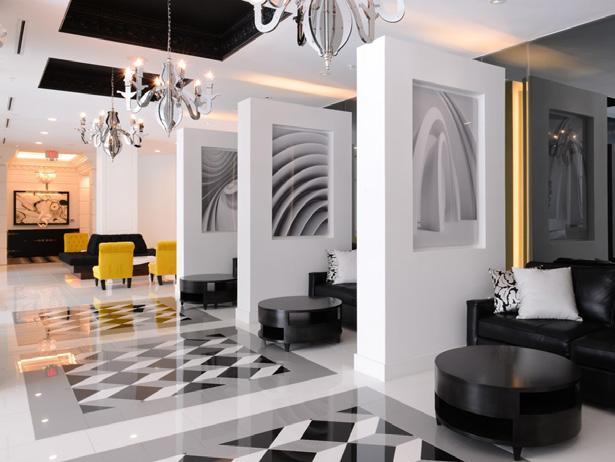
Initially, you should think about the foot traffic in the office, warehouse, and other spaces you’re called to renovate. A place that has a lot of people coming and going will need to stand up to constant dirt, debris, and scuffs. Add to the stream of constant footwear a regular barrage of pallet trucks or forklifts, and you may want to eschew carpet in favor of heavy-duty, high-performance, commercial-grade flooring.
Similarly, always think about how you, your property maintenance team, or your clients will maintain new commercial floors.
Chances are strong no one on staff wants to spend all day making sure every mark is erased. Not only does that eat up valuable time, but it’s also unnecessary if you
FLOORING OPTIONS: A GO-TO GUIDE 16
choose the right floors. Fast clean-up is critical in most commercial environments, which is why ceramic and luxury vinyl tile are frequent requests of interior designers. Natural stone and vinyl tend to appeal to business owners or property management teams willing to commit some elbow grease to floor maintenance, but not hours’ and hours’ worth. And carpet is still a choice as long as it’s regularly deep-cleaned to keep it from becoming filthy, soiled, or ragged.
Finally, be sure any commercial flooring you choose won’t get slippery when exposed to moisture. Areas like entrances, exits, and even bathrooms need supportive traction. Carpet can provide some help with wetness, although it’s tough to keep mold from building up. A better solution for moisture-laden locations may be textured rubber flooring, luxury vinyl or, of course, tile.
Regardless of the type of commercial floor chosen, you still can find a wealth of color and texture choices to set the desired mood. For instance, if the space needs to reflect a sense of quietude, choose warm-colored carpeting surrounded by furnishings and decor in neutral and warm shades. If you’re interested in fostering a spirited environment that bursts forth with liveliness, as in the playroom of a daycare or church, try brighter shades punctuated by eye-catching textures.
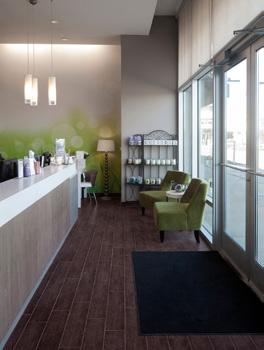
If you truly want your clients’ floors to impress anyone who walks in their doors, marble flooring, porcelain floor tiles, or even a gorgeous hardwood will do the trick.
The sky’s the limit (or should we say “ground?”) when it comes to selecting the right flooring to convey a particular atmosphere at an office, shop, or headquarters. ProSource Wholesale is ready to help make your commercial project come to life brilliantly with flooring that fits right in — literally and figuratively.
17
FLOORING OPTIONS: A GO-TO GUIDE
BRINGING YOUR FLOORING DECISIONS TOGETHER
Feeling a little dizzy with so many flooring alternatives at your fingertips? Before you get too overwhelmed, remember: You don’t have to make your selections quickly. Similarly, you don’t have to get locked in to a specific trend. You should feel free to buck the trendy for the evergreen if it benefits you or your clientele. And finding a floor to marry for the long haul isn’t tough when you map out a strategy.
When you’ve determined your design objectives — or your client’s goals — you can begin to create a plan for making your home renovation project’s dreams come true.
Ready to begin your journey? Use the checklist below when visiting your local ProSource showroom to look at samples, engage in discussion, and innovate like never before!
ProSource Wholesale® is the source for home remodeling success. We cater exclusively to trade professionals and their homeowner clients. Our private showrooms display flooring, kitchen and bathroom products at low, wholesale prices. Plus, we offer dedicated service that’s tailored to your needs. Find your local showroom at prosourcewholesale.com/showrooms or call 1-800-787-7748.
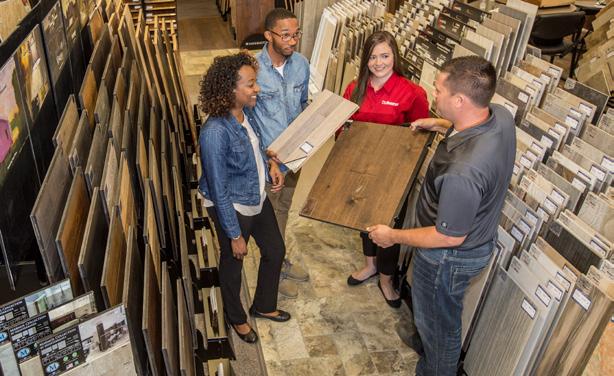
© LEMI – ProSource 2019
Residential Flooring Checklist
Check off all styles of flooring that make sense for your residential client:
1. What type of flooring does your client prefer?
a. Hard surface (go to No. 2)
b. Soft surface (go to No. 3)
c. Waterproof
d. One that accomodates high traffic
e. Pet-friendly and/or kid-friendly
2. Which hard surface flooring matches the client’s space needs? (go to question No. 4)
a. Solid hardwood
b. Engineered hardwood
c. Tile
d. Luxury vinyl tile or plank
3. What type of soft surface flooring matches the client’s space needs?
a. Carpet
b. Carpet tile
c. Area rug
4. What flooring color palettes does your client want to consider?
a. Neutrals (white, beige, gray, brown, black)
b. Soft colors (pastels, muted hues)
c. Warm colors (Gold Rush, orange, rust)
d. Cool colors (ultraviolet, poppy red, bright yellow)
e. Not sure; I’ll have to decide at the ProSource showroom
5. How important is an eco-friendly flooring choice?
a. Very important: a must-have for the home
b. Neither important nor unimportant
c. Not important
d. It will depend upon the final selection
6. Does your client need commercial floors in their home?
a. Yes, for a home office area
b. No
c. I’m not sure
7. Do your clients want an eco-friendly hard surface floor? If so, which of these options are they interested in?
a. Cork or bamboo
b. Luxury vinyl tile or planks
c. Solid or engineered hardwood

8. Is your client interested in cork or bamboo flooring? Consider these characteristics to help the client narrow down a choice:
a. Cork is softer than bamboo and provides a “cushion” feel.
b. Cork floors provide natural thermal and acoustic insulation, making them warmer to walk on and effective at reducing sound in open spaces.
c. Cork is waterproof and long-lasting.
d. Bamboo is hard (like wood flooring) but resists staining, scuffing, and scraping better than hardwood.
e. Bamboo is somewhat water-resistant, but it’s not ideal in damp climates where continued exposure to moisture can warp the floorboards.
f. Bamboo is made of natural materials and is eco-friendly.
9. When to suggest luxury vinyl tiles or planks:
a. The client is on a tight budget but wants the look and function of ceramic tiles or wood planks.
b. An eco-friendly floor is desired.
c. Durability is very important.
d. Flooring must be easy to clean and care for.
10. If the client needs hard surface flooring for the hallway, ask which option is preferred:
a. Solid hardwood
b. Engineered hardwood
c. Luxury vinyl tile
d. Natural stone
11. If your client wants carpet, ask these questions to narrow down the selection:
a. Do they want wall-to-wall carpet or just a portion of the flooring space done with carpet?
b. Is it a high-traffic area?
c. Does the carpet need to be waterproof or water-resistant?
d. Are there allergy concerns?
e. Does the carpet need to be eco-friendly?
f. Does the carpet need to be stain-resistant, pet-friendly, and/or child-friendly?
Commercial Flooring Checklist
Check off all styles of flooring that make sense for your commercial client:
1. What questions should be asked before selecting flooring for a commercial building?
a. How much foot traffic will there be in each area?
b. Will there be pallet carts or other equipment used in the area(s) that may be rough on the flooring?
c. Will the area be exposed to moisture, requiring water-resistant flooring?
d. Are there bathrooms or break rooms that need flooring?
2. Commercial buildings often need floors with fast cleanup: Which flooring type is your client interested in?
a. Different versions of carpet
b. Ceramic and/or luxury vinyl tile choices
c. Natural stone
d. Hardwood
3. If your client wants a hardwood look (but not real hardwood), which option might interest her?
a. Luxury vinyl planks
b. Cork
c. Luxury vinyl tile
4. If the area is dust-prone, which eco-friendly flooring is your client interested in?
a. Eco-conscious carpeting
b. Natural cork
c. Tile
5. If the commercial building mainly houses forklifts and trucks, what type of flooring does your client want?
a. Aesthetically pleasing flooring
b. Heavy-duty and high performance-based flooring
c. High-performance but not necessarily heavy-duty
6. If the client wants to provide a quiet atmosphere in a commercial building, what carpet color groups could you suggest?
a. Neutrals or warm colors like beige or brown (i.e., Cavern Clay)
b. Cool colors like ultraviolet or poppy red
c. Not sure
7. If the building is similar to a library (with expansive floor space that needs to stand up to heavy foot traffic yet be easy to keep clean), which of the following flooring types would the client prefer?
a. Solid hardwood
b. Natural cork






 FLOORING OPTIONS: A GO-TO GUIDE 5
FLOORING OPTIONS: A GO-TO GUIDE 5












